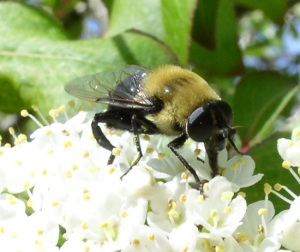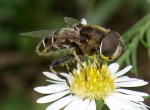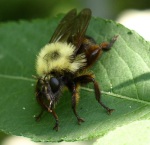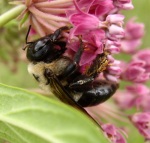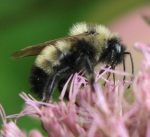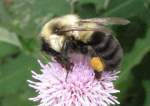We think that we know what a bumble bee looks like, but often we are deceived by some very good imitators. There are a number of flies that masquerade as bumble bees despite the fact that they have only two wings, instead of four and that their antennae are significantly shorter. There are even a few moths and beetles that imitate bumble bees.
Flower flies, also called hover flies or Syrphid flies visit flowers frequently and are good imitators of bees or wasps. They lack stingers, but their appearance gives them some protection from hungry birds that fear the sting of a bee and are left alone. Some are specialized to look like bumble bees. This mimicry occurs in other continents, too, with European and American flies mimicking European and American species of bumble bees respectively.
Robber flies are ferocious predators, capable of catching some insects in flight. Among them, there are some that imitate bumble bees so convincingly that they can fool anybody, including experts. In this case, the purpose of the mimicry may be to fool their prey, as well, as their possible predators.
Some beeflies and also tachinid flies are good mimics of bumble bees.
Carpenter bees also look very much like bumble bees. The main difference is their glossy and almost hairless abdomen, while bumble bees are covered by fuzz all over. In this case the mimicry would benefit both of them.
Curiously enough, some species of bumble bees are mimics of each other, although they may not be closely related. Some of the cuckoo bumble bees seem to be mimics of their hosts, for instance, Bombus citrinus and its host Bombus impatiens.
The mimicry makes it very hard to tell the species of bumble bee apart. The similarity among bumble bee species probably provides them additional protection. Predators need to learn the lesson only once instead of twice. In fact, this kind of mimicry may help the males, also, since they lack stingers.
